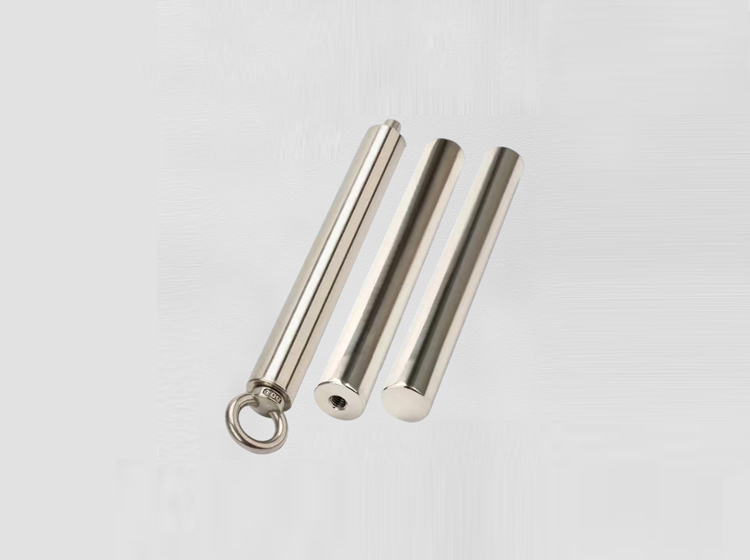In the current domestic market, with the rapid development of new energy, the strict demagnetization process in lithium battery production has propelled the application of powerful neodymium iron boron (NdFeB) magnetic rods into a completely new field. Starting from the powder feeding process, a magnetic holder is placed in the hopper, with a minimum magnetic strength of 10,000 Gauss. The powder material then goes through a sand mill before entering the nano grinding process. The resulting slurry after grinding needs to undergo magnetic separation using a pipeline iron remover, which typically uses a magnetic strength of 12,000 Gauss or 13,000 Gauss. Whether it's the magnetic holder or the pipeline iron remover, the conventional choice is a circular magnetic rod with diameters typically ranging from 25mm, 32mm, to 40mm, and the magnetic strength can range from 10,000 Gauss, 12,000 Gauss, 13,000 Gauss, to 14,000 Gauss, with larger diameters achieving higher magnetic field intensity on the surface.
A good magnetic rod should have a uniform distribution of magnetic induction lines in space, and the distribution of maximum magnetic induction points should ideally cover the entire length of the magnetic rod. Since these rods are usually placed in moving product conveyor lines, their surface should be smooth with minimal resistance and free from harmful substances to avoid contaminating materials and the environment.
The working environment of the magnetic rod dictates that it must have corrosion resistance, high-temperature resistance, and in some cases, a strong magnetic induction intensity. Different thicknesses of magnetic sheets can achieve varying levels of magnetic induction intensity. The choice of different magnets determines the maximum magnetic induction strength and temperature resistance of the magnetic rod. Typically, to achieve a surface magnetic induction intensity of over 10,000 Gauss on a regular Ф25 magnetic rod, a high-performance type of neodymium iron boron magnet is required. For high-temperature resistance, samarium cobalt magnets are chosen when temperatures exceed 150 degrees. However, for large-diameter magnetic rods, samarium cobalt is not the preferred choice due to its high cost, with the price of a single magnetic rod reaching thousands of dollars.
Various types of strong magnetic filter rods

The surface magnetic induction strength of the magnetic rod is directly proportional to the minimum particle size it can adsorb, but in fields such as batteries and pharmaceuticals, even small iron impurities can have significant effects. Therefore, magnetic rollers with strengths above 12,000 Gauss (Ф110-Ф220) should be chosen. In other fields, a slightly lower strength magnetic rods can be selected.
During the process of contact with fluids, the internal magnetic energy of the magnetic rod may experience irreversible losses. When the loss exceeds 30% of the original strength or when the surface is covered with corroded iron or steel, it's time to replace the magnetic rod. It's not advisable to continue using a magnetic rod with exposed magnets, as magnets are generally brittle and coated with oil, leading to significant environmental pollution. Typically, domestically produced magnetic rods can work under heavy loads for 1-2 years and under light loads for 7-8 years. They are mainly used in industries such as plastics, food, environmental protection, filtration, chemicals, power, construction materials, ceramics, pharmaceuticals, powders, mining, and coal, among others.
Related magnet products;
 China Neodymium And Ferrite Magnets Manufacturer & Supplier
China Neodymium And Ferrite Magnets Manufacturer & Supplier 


